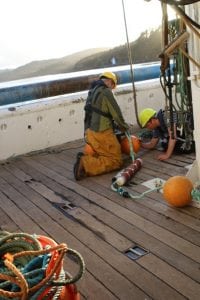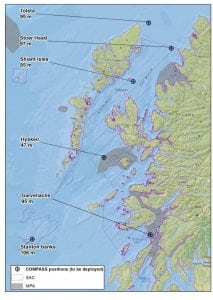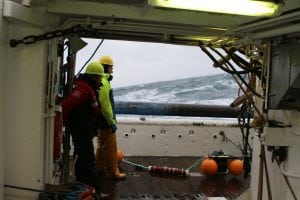Marine
Hearing things with COMPASS
November 29, 2017 by Marine Directorate Communications No Comments | Category Collaborations, Marine Directorate Science, Marine Directorate Surveys, Research Vessel Surveys
On November 6th the Alba na Mara set sail once more to deploy acoustic listening devices in the west coast of Scotland. A total of six moorings containing broadband sound recording devices and cetacean echolocation “click detectors” were to be deployed during the trip. The map below gives the planned locations for deployment.
These deployments were the first instalment of a collaborative biological monitoring network that will form part of a five year collaborative project called COMPASS, funded under EU INTERREG VA. The COMPASS network of moorings aims to gather data that will characterise and monitor the marine environment in relation to protected areas and species, and improve oceanographic models in Scottish, Northern Irish and Irish waters.

Figure 2: MSS scientists on Alba na Mara preparing moorings for deployment
The COMPASS deployment positions were spread out around the Minches strategically to gather relevant acoustic data. Shipping lines, fishing activity, physical processes and marine fauna all generate noise. This array seeks to discern their contribution to the acoustic environment. For example the northmost mooring at Tolsta will provide data that will help to generate an acoustic baseline for the well-established shipping lane noise through the winter. Other deployments have been sited within or in the vicinity of the Inner Hebrides and the Minches pSAC to protect harbour porpoises, and one of the moorings will be in the Stanton Banks protected area. The variety of habitats that the array covers will create a highly informative and varied data set, and will be used to explore the importance of underwater noise in influencing the quality of the marine environmental quality for marine mammals.
Alba also recovered moorings that had been deployed at eight positions in the Minches under EMFF funding in August 2017. Some of these were not collected due to weather constraints and will be re-visited as soon as it becomes logistically possible.
During the survey we gave Ross Culloch a newly employed cetacean scientist in the Renewables and Energy Programme, his first taste of the Alba na Mara, and hosted Denise Risch from SAMS, Dunstaffnage.
The weather did not exactly play ball and a few decisions were based around maximising the outcomes despite the strong winds and rough seas. But that is what can be expected at this time of year in the Minches.
We will keep you updated on the next cruises for this project.
Further Information
- Previous blog about this survey (6 Nov 2017): At Loggerheads with PAM
- Marine Scotland research vessels and surveys
- Other research vessel survey blogs
Tags: Alba na Mara, COMPASS, echolocation, Inner Hebrides, marine environment




Leave a comment